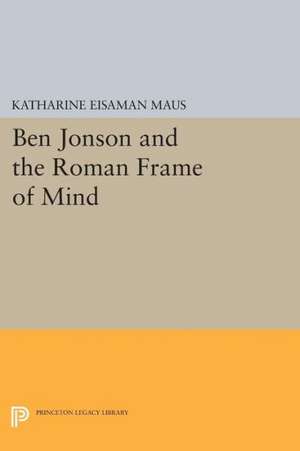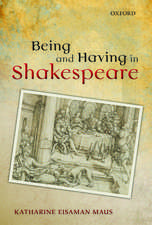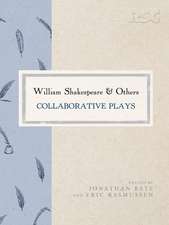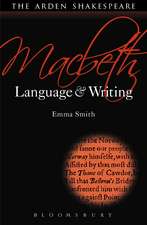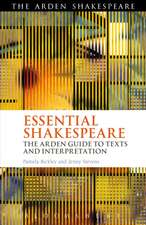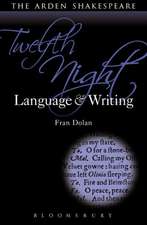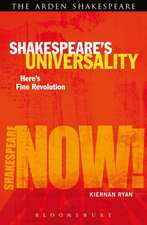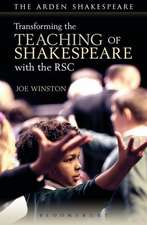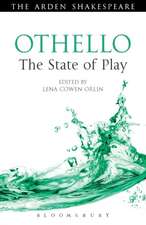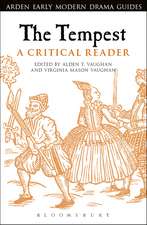Ben Jonson and the Roman Frame of Mind: Princeton Legacy Library
Autor Katharine Eisam Mausen Limba Engleză Paperback – 30 iun 2014
| Toate formatele și edițiile | Preț | Express |
|---|---|---|
| Paperback (1) | 286.87 lei 6-8 săpt. | |
| Princeton University Press – 30 iun 2014 | 286.87 lei 6-8 săpt. | |
| Hardback (1) | 554.82 lei 6-8 săpt. | |
| Princeton University Press – 18 apr 2016 | 554.82 lei 6-8 săpt. |
Din seria Princeton Legacy Library
-
 Preț: 437.79 lei
Preț: 437.79 lei -
 Preț: 172.27 lei
Preț: 172.27 lei - 16%
 Preț: 683.63 lei
Preț: 683.63 lei - 16%
 Preț: 2324.11 lei
Preț: 2324.11 lei -
 Preț: 376.99 lei
Preț: 376.99 lei - 23%
 Preț: 780.26 lei
Preț: 780.26 lei -
 Preț: 377.31 lei
Preț: 377.31 lei -
 Preț: 313.18 lei
Preț: 313.18 lei - 16%
 Preț: 882.80 lei
Preț: 882.80 lei - 16%
 Preț: 736.40 lei
Preț: 736.40 lei - 16%
 Preț: 860.09 lei
Preț: 860.09 lei -
 Preț: 362.12 lei
Preț: 362.12 lei -
 Preț: 223.24 lei
Preț: 223.24 lei -
 Preț: 363.10 lei
Preț: 363.10 lei - 16%
 Preț: 915.48 lei
Preț: 915.48 lei -
 Preț: 340.22 lei
Preț: 340.22 lei - 16%
 Preț: 835.12 lei
Preț: 835.12 lei -
 Preț: 266.84 lei
Preț: 266.84 lei -
 Preț: 317.65 lei
Preț: 317.65 lei -
 Preț: 329.09 lei
Preț: 329.09 lei -
 Preț: 265.73 lei
Preț: 265.73 lei -
 Preț: 260.54 lei
Preț: 260.54 lei -
 Preț: 314.84 lei
Preț: 314.84 lei -
 Preț: 402.66 lei
Preț: 402.66 lei -
 Preț: 464.18 lei
Preț: 464.18 lei -
 Preț: 351.09 lei
Preț: 351.09 lei -
 Preț: 483.81 lei
Preț: 483.81 lei - 19%
 Preț: 500.29 lei
Preț: 500.29 lei -
 Preț: 388.44 lei
Preț: 388.44 lei -
 Preț: 328.48 lei
Preț: 328.48 lei - 23%
 Preț: 742.04 lei
Preț: 742.04 lei -
 Preț: 372.92 lei
Preț: 372.92 lei -
 Preț: 328.70 lei
Preț: 328.70 lei - 19%
 Preț: 505.89 lei
Preț: 505.89 lei -
 Preț: 446.25 lei
Preț: 446.25 lei -
 Preț: 289.17 lei
Preț: 289.17 lei - 19%
 Preț: 575.53 lei
Preț: 575.53 lei -
 Preț: 447.20 lei
Preț: 447.20 lei -
 Preț: 484.19 lei
Preț: 484.19 lei -
 Preț: 271.12 lei
Preț: 271.12 lei -
 Preț: 314.46 lei
Preț: 314.46 lei -
 Preț: 362.51 lei
Preț: 362.51 lei -
 Preț: 307.07 lei
Preț: 307.07 lei - 19%
 Preț: 498.46 lei
Preț: 498.46 lei -
 Preț: 272.27 lei
Preț: 272.27 lei - 19%
 Preț: 458.44 lei
Preț: 458.44 lei -
 Preț: 406.20 lei
Preț: 406.20 lei - 19%
 Preț: 515.73 lei
Preț: 515.73 lei -
 Preț: 428.88 lei
Preț: 428.88 lei -
 Preț: 369.27 lei
Preț: 369.27 lei
Preț: 286.87 lei
Nou
Puncte Express: 430
Preț estimativ în valută:
54.90€ • 57.10$ • 45.32£
54.90€ • 57.10$ • 45.32£
Carte tipărită la comandă
Livrare economică 15-29 aprilie
Preluare comenzi: 021 569.72.76
Specificații
ISBN-13: 9780691611969
ISBN-10: 0691611963
Pagini: 224
Ilustrații: black & white illustrations
Dimensiuni: 159 x 234 x 13 mm
Greutate: 0.32 kg
Editura: Princeton University Press
Seria Princeton Legacy Library
ISBN-10: 0691611963
Pagini: 224
Ilustrații: black & white illustrations
Dimensiuni: 159 x 234 x 13 mm
Greutate: 0.32 kg
Editura: Princeton University Press
Seria Princeton Legacy Library
Descriere
Descriere de la o altă ediție sau format:
Katharine Maus explores the biographical reasons for Jonson's preference for particular Latin authors; the effects of Roman moral and psychological paradigms on his methods of characterization and generic choices; the connection between his critical theory and artistic practice; and the impact of Roman social theory on his portrayal of communities
Katharine Maus explores the biographical reasons for Jonson's preference for particular Latin authors; the effects of Roman moral and psychological paradigms on his methods of characterization and generic choices; the connection between his critical theory and artistic practice; and the impact of Roman social theory on his portrayal of communities
